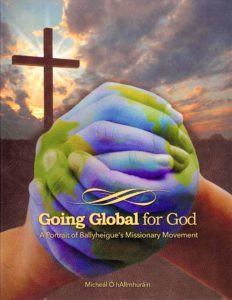Going Global for God: A Portrait of Ballyheigue’s Missionary Movement
by Micheál Ó hAllmhuráin (Ballyheigue History and Heritage Group; phone: (066) 7133110 (during office hours only), email: ballyheigue@dioceseofkerry.ie)
This is a splendid tribute to the men and women from the small parish in Ballyheigue in Co Kerry who spent their lives on the missions at home and abroad.
The book is beautifully shaped, and provides a local microcosm of Ireland’s national missionary activity over the recent centuries.
At the outset there is an account of the five priests who served in the home diocese of Kerry. Then there were the Ballyheigue natives who served in Dublin. Fr Paddy Kelly, a member of the archdiocese, was renowned for his dedication to the poor and the sick. His sheer goodness and saintliness was recognised by his colleagues.
A standard joke among them was that, if ever there was to be an apparition in South Wicklow, where Paddy ministered, it would be of Paddy to the Blessed Virgin rather than the reverse!
Appointments
Frs Cornelius (Jody) Crowley and Luke Delaney were members of the Passionist order. Both held a variety of appointments at home and abroad. During World War II, Fr Crowley was chaplain to the Parachute Regiment, serving in Norway and Palestine.
He was awarded ‘The Red Beret’, but returned it with his British credentials to the War Office in London in protest after the Regiment’s involvement in ‘Bloody Sunday’ in Derry in January 1971.
Twenty-four Sisters from the parish served in convents throughout Ireland. Most of them spent some 50 years teaching in and managing schools or caring for the poor and the sick. They provided the sinews and substance of the educational and medical services of the Irish Free State across almost three generations.
For their total commitment to the well-being of Ballyheigue’s ‘Going Global for God’ is to be seen in the context of the country’s overall missionary movement overseas. While European countries were carving out and maintaining empires, Irish priests and religious were establishing what was described as ‘a spiritual empire’.
Ballyheigue’s participation in that ‘empire’ was remarkable. The record shows that priests and religious from the parish ministered abroad as follows: Africa (Br 1, Srs 5, Ps 2), Asia (Sr 1), Australia (Srs 13, Ps 5), Britain (Srs 9, Ps 5), Canada (Br 1), Mainland Europe (Br 1, Ps 2), South America (Srs 2, Ps 2), US (Srs 31, Ps 21). The success of their evangelisation is evinced by the manner in which the convents, communities, hospitals, schools and parishes, where they ministered, flourished.
Apart from spreading the Gospel, the Ballyheigue missionaries provided much-needed support for our exiles, particularly in Australia and the US. They were also to the fore in promoting Irish cultural pursuits and past-times in their colleges and schools.
Ballyheigue was the ‘heimat’ of 11 long-serving members of the Irish Christian Brothers.
They spent their lives teaching in primary and secondary schools throughout Ireland as well as in Gibraltar, Newfoundland and South Africa. Their primary outreach, like that of their colleagues, was to ensure that education was accessible to the poor and the underprivileged. Despite tight schedules, they also found time to play a major role in popularising our Gaelic games.
All those Brothers, Sisters and priests from the area are listed together with their family factfiles. In setting the context of their various commitments the author provides a mine of information on the Catholic Church in Ireland and seminaries, as well as on the dioceses and the congregations and orders to which those priests and religious belonged.
Every element of this volume – art-work, paper, printing, design, colouring, layout – merits a superlative. It has a priceless collection of illustrations. Reading it is far from just a literary exercise. It is an enhancing experience.
Congratulations and thanks are due to the author and all who contributed to this truly magnum opus which highlights our glorious missionary heritage.


 Going Global for God: A Portait of Ballyheigue's Missionary Movement
Going Global for God: A Portait of Ballyheigue's Missionary Movement